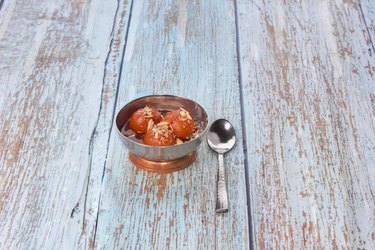
Gulab jamun is a type of dessert that originated in the Indian subcontinent. Here's what you need to know about gulab jamun in terms of its nutrition information. If you're wondering whether gulab jamun has any health benefits, don't hold your breath.
Video of the Day
Video of the Day
What Is Gulab Jamun, Exactly?
Jamun is actually the name of a round, purple-colored berry that is found on the Indian subcontinent. The dessert is named after this berry because the spheres are similar in size and shape. The sugar syrup that the spheres are served in is flavored with rose, or gulab, as the flower is known in Hindi.
Gulab jamun is traditionally made with khoya, which is the milk solids that remain after the moisture in milk has been evaporated. Khoya, also referred to as mawa, can be made from scratch or purchased in ready-made form. If khoya is not readily available, it can be substituted with a combination of powdered milk and either ghee or butter, since making khoya from scratch can be a time-consuming affair.
To make gulab jamun, khoya is mixed with flour and baking powder and shaped into round balls using a little milk. These balls of dough are deep fried in either oil or ghee and then soaked in a sticky syrup made by boiling water and sugar. Rose water and cardamom powder are added to the syrup to flavor it.
Slivered nuts like almonds and pistachios are sometimes sprinkled on top of gulab jamun as a garnish. Though it is usually served hot, gulab jamun can also be eaten cold, depending on your preference.
Gulab jamun is often found on the menu at Indian restaurants and is sometimes available for purchase at grocery stores. You may also find it at Indian events like weddings. A study published in the April 2015 issue of the journal Family and Community Health notes that Indian desserts like gulab jamun are closely linked to auspicious events, rituals and special occasions in Indian culture.
Gulab Jamun Nutrition Information
The USDA lists gulab jamun's nutrition information. As you may have guessed, gulab jamun is a calorie-rich dessert. A 100-gram serving of gulab jamun has 432 calories. Galub jamun's calories are primarily from carbs; however it does contain protein and fat as well. One hundred grams of gulab jamun provides 56 grams of carbs, 16 grams of protein and 16 grams of fat.
Given that it's a milk-based product, gulab jamun is a source of calcium and vitamin A in addition to protein. Per the USDA, 100 grams of gulab jamun offers 100 milligrams of vitamin A and 300 milligrams of calcium, which is roughly one-third of your daily calcium requirement, as prescribed by the National Institutes of Health.
So, does eating gulab jamun offer any health benefits? On the contrary, gulab jamun doesn't offer any health benefits, or any significant ones at least, but can cause health problems instead. A study published in the December 2014 issue of the journal Nutrients found that sugary, energy-dense desserts like gulab jamun are contributing to the growing epidemic of obesity and diabetes in India.
Given that it's deep fried and soaked in sugar syrup, the Centers for Disease Control and Prevention recommends skipping it, or limiting yourself to a small portion.
- U.S. National Library of Medicine: “Asian Indian Views on Diet and Health in the United States”
- USDA: “Gulab Jamun Mix”
- National Institutes of Health: “Calcium”
- Centers for Disease Control and Prevention: “Choosing Healthy Foods on Holidays and Special Occasions”
- U.S. National Library of Medicine: “Sugar Intake, Obesity and Diabetes in India”
Was this article helpful?
150 Characters Max
0/150
Thank you for sharing!
Thank you for your feedback!